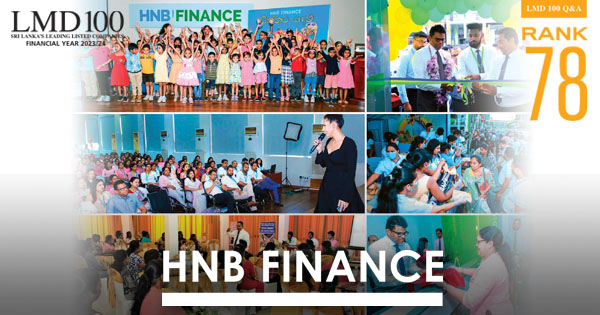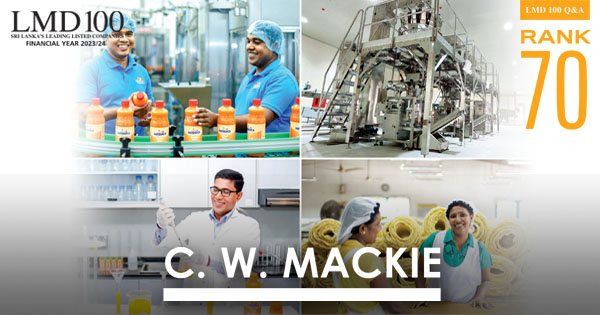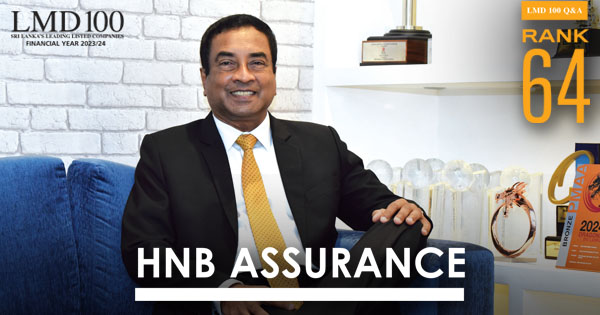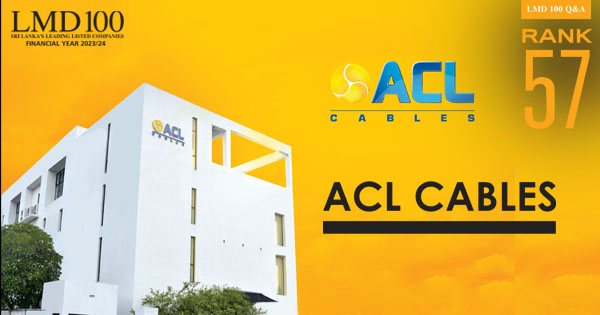LITMUS TEST
HIGH-WATER MARK
How Sri Lanka’s leading business houses are navigating the fluctuating tide of the nation’s economic growth programme
 The 2014/15 LMD 100 special edition mirrors the balancing act that the island’s foremost listed entities are having to perform, in an era that has been hailed as a game changer – in the socio-political and macroeconomic frames, as well as in the eyes of the international community. And while there have been ups and downs, on the national front, the contribution that private sector establishments continue to make, in driving Sri Lanka’s engine of growth through troubled waters, is not in doubt.
The 2014/15 LMD 100 special edition mirrors the balancing act that the island’s foremost listed entities are having to perform, in an era that has been hailed as a game changer – in the socio-political and macroeconomic frames, as well as in the eyes of the international community. And while there have been ups and downs, on the national front, the contribution that private sector establishments continue to make, in driving Sri Lanka’s engine of growth through troubled waters, is not in doubt.
Indeed, following the presidential and parliamentary polls earlier this year, the corporate sector is seeking greater clarity regarding its role in setting the Sri Lankan economy on a path to progress and prosperity. It goes without saying that the nation has faced setbacks, even in the post-conflict years, and there’s a sense of growing impatience as to whether the new Government’s promise of good governance will see the light of day.
In this scenario, the proposed economic reform agenda – while it has by and large been welcomed by business and chamber types – must contend with the domestic and foreign realities with which corporates and the state sector alike are faced.
To cap it all, the business community’s reaction to the recently presented Budget 2016 will be an eye-opener for prospective investors, both local and foreign. Will the so-called ‘revolution’ bear fruit, or fizzle out into being ‘more of the same’ in different wrapping paper?
 Answers aside, as the latest LMD 100 reveals, Sri Lanka’s top-flight corporate houses continue to blaze a trail for others to follow, despite the many twists and turns in the country’s recent socio-economic and political history.
Answers aside, as the latest LMD 100 reveals, Sri Lanka’s top-flight corporate houses continue to blaze a trail for others to follow, despite the many twists and turns in the country’s recent socio-economic and political history.
Many of the ‘Corporate Firebrands’ highlighted in the 2013/14 edition of the LMD 100 continue to play a decisive role in the direction of Sri Lanka Inc., while the new entrants are adding a fresh flavour to the latest rankings… they offer a hint of the trajectory that listed ventures could take, in the year ahead.
LEADERBOARD One of the country’s largest diversified entities heads the latest LMD 100 listing, creating an upset of sorts, by unseating a corporate powerhouse that has helmed the rankings for many years. Meanwhile, an oil-palms-centric corporate, and an oil and gas corporation – both with foreign ties – follow hot on their heels, stamping their mark on the 2014/15 Leaderboard.
In the past, John Keells Holdings (JKH) was ranked No. 1 in eight of the first 10 years of The LMD 50’s (the pioneering precursor to the LMD 100) existence, only to be surpassed by Sri Lanka Telecom (SLT) – a partnership between the Government of Sri Lanka and Malaysian telecom giant Maxis, which went public in 2003.
SLT, in turn, helmed the rankings for four consecutive years, before surrendering its place at the top of the ladder to a petro giant from neighbouring India – Lanka Indian Oil Corporation (Lanka IOC) was The LMD 50’s numero uno until 2009/10, its reign lasting three years.
And Hayleys, which was runner-up to JKH in many of the early years – and pipped the latter to the winning post in 1995/96 and 1996/97 – also raced ahead of SLT and Lanka IOC in 2010/11, to occupy the podium’s second place.
In the latest LMD 100 rankings, Hayleys takes the No. 1 spot, while JKH surrenders its leadership status to receive the runner-up title. Bukit Darah crawls one spot up the famed ladder, to third place, and is followed by Lanka IOC in fourth place. Commercial Bank (ComBank) rounds off the top five, as it did in the prior year.
The remainder of the Leaderboard consists of Dialog Axiata (No. 6), SLT (in seventh place) and Hatton National Bank (HNB), at No. 8, as well as CT Holdings and Cargills (Ceylon) – they’re placed ninth and 10th respectively.

REVENUE STREAMS Aggregate revenues of the island’s 100 largest quoted business houses amounted to Rs. 2,139 billion in 2014/15, reflecting an annual growth of five percent. We’re inclined to surmise that, while this increment in combined annual earnings is above the official rate of inflation for the period under review, there’s room for improvement. In the preceding financial year, the LMD 100 cumulative turnover turned up by 10 percent, despite inflation being in the low single digits.
Meanwhile, over a third (36) of the LMD 100 registered annual revenue streams in excess of 20 billion rupees – the same number as in 2013/14. The three highest ranked corporates (Hayleys, JKH and Bukit Darah) also surpassed the 80 billion rupees mark in financial year 2014/15.
In terms of revenue upside, Commercial Credit & Finance comes out on top, with a 66 percent year-on-year uptick in income, to Rs. 12.3 billion. It was also the only LMD 100 entity to report top line improvement in excess of 50 percent in 2014/15.
BOTTOM LINES The 2014/15 LMD 100 cumulative post-tax profit increased by 14 percent, versus the previous year, to nearly 195 billion rupees. And the after-tax profit of JKH, ComBank and HNB also crossed the Rs. 10 billion landmark.
Meanwhile, five of Sri Lanka’s LMD 100 companies ended the 2014/15 financial year in the red – viz. Lanka Milk Foods, Colombo Fort Land, Lankem Ceylon, Kotagala Plantations and FLC Holdings – versus a count of 10 in the preceding year.
The big picture on the profitability front, therefore, is apparently healthier than income generation in 2014/15. This, perhaps, is a reflection of the measures taken by corporates to tighten their belts, through cost rationalisation and other means. Add to this equation, the fact that the combined bottom line of the LMD 100 in 2013/14 reflected a contraction to the tune of six percent from the previous year, and it is clear that fortune has favoured Sri Lanka’s listed companies in 2014/15.
As for movers and shakers, CIC Holdings (2,870%), E. B. Creasy (131%), Commercial Credit & Finance (118%) and Lanka Orix Leasing Company – aka LOLC – (102%) lead the way, from among the top 50 listed companies.
TAXATION On average, an LMD 100 entity forked out 646 million rupees in taxes for 2014/15, representing an annual hike of 18 percent from the previous year’s bill of Rs. 546 billion.
The Leaderboard accounts for 31 percent of the combined taxes of the LMD 100 in 2014/15, as the top 10’s payout rose by five percent (versus 25%, in 2013/14), to over 20 billion rupees. And, as has been the norm, Ceylon Tobacco Company (CTC) made the largest contribution to state coffers during the period, thanks to a Rs. 6 billion corporate tax charge.
ASSET VALUES The largest listed entities in Sri Lanka witnessed a substantial appreciation in asset values, with the top half of the LMD 100’s balance sheet appreciating by 15 percent from the prior year, to nearly 6.1 trillion rupees by the end of 2014/15. This growth is largely in line with the 16 percent and 18 percent uplift in asset values recorded in 2013/14 and 2011/12, respectively.
The financial services industry continues to exert its dominance in the LMD 100’s asset-related rankings, tipping the scales with a cumulative asset portfolio of nearly 3.9 trillion rupees. ComBank leads the way, with Rs. 797 billion in assets at 31 December 2014, followed by another private sector banking giant HNB (Rs. 600 billion) and Sampath Bank(Rs. 443 billion).
Commercial Credit & Finance comes out ahead, in terms of the highest percentage gain in asset values among the top 50 – its total assets of 59 billion rupees reflect an 87 percent appreciation from the end of the prior year.
MTD Walkers is next in line, with a 42 percent increment, while LOLC also joins the party, given that its asset base expanded by 40 percent in 2014/15.
MOVERS AND SHAKERS Commercial Credit & Finance made the most notable progress, in terms of climbing up the rankings – it moves into the top 50 listed entities in 2014/15, at No. 49 – up 20 places from the preceding year. MTD Walkers also makes its presence felt, improving its position by 12 spots (to No. 46) in the rankings.
In sum, 27 (versus 19, in financial year 2013/14) of the island’s largest corporate entities climbed up the LMD 100 ladder.
SECTOR RANKINGS The diversified holdings sector holds sway over the others amongst the leading listed companies, with a cumulative turnover of Rs. 562 billion in 2014/15 – that represents more than a quarter of the LMD 100’s combined income during the period.
Sri Lanka’s financial services industry is the second-largest player in the LMD 100, with an aggregate income in excess of 527 billion rupees. The sector lays claim to the highest contribution to total profits, asset values and shareholders’ funds in 2014/15: it accounts for 37 percent of the LMD 100’s aggregate after-tax profits, 65 percent of combined assets and just over a third of funds attributable to shareholders.
The island’s largest conglomerates, as well as the banks, finance companies and insurance firms, are the lead lights among the nation’s listed corporations. Collectively, the two sectors account for more than half of the LMD 100’s revenue and aggregate bottom line.
INVESTOR YARDSTICKS JKH remains the market’s darling, thanks to a market capitalisation of Rs. 199 billion at 31 March 2015.
The highly diversified conglomerate is trailed by CTC, which registered a market cap of 187 billion rupees at the end of financial year 2014/15, while Commercial Bank and Nestlé Lanka were the only other entities with a capitalisation in excess of 100 billion rupees.
In aggregate terms, the LMD 100’s combined market capitalisation gained 17 percent (to register Rs. 2,216 billion) between 1 April 2014 and 31 March this year.
Improving on its standing in the preceding financial year, 10 of the island’s 100 leading listed corporates maintained an equity value of over 50 billion rupees at the end of 2014/15. And the top five (JKH, CTC, ComBank, Nestlé and Dialog) accounted for a third of the LMD 100’s market capitalisation.

THE FUTURE The year ahead will see the recently elected Administration put to the test on its many socio-economic and political promises. This, in turn, will likely have a major bearing on the outlook for business – and thus, the performance of corporate Sri Lanka.
In a communique released in November, the Ceylon Chamber of Commerce (CCC) – the oldest and most influential chamber in Sri Lanka – welcomed the recent economic policy statement presented by Prime Minister Ranil Wickremesinghe, asserting that it “provides important direction on the Government’s future plans for the Sri Lankan economy.”
The CCC also highlights the proposed changes to the export policy and promotion regime, including the creation of a new International Trade Agency which, it says, “will be critical in aggressively pushing Sri Lankan exports into current and new markets abroad.”
“The focus on small entrepreneurs and regional economic development is also welcome, as there still remain significant gaps in prosperity between leading and lagging regions,” it adds.
As for the world economy, which must also be factored into this equation, the International Monetary Fund (IMF) has noted that prospects across the major countries and regions remain uneven.
The international lending agency is of the view that “the recovery in advanced economies is expected to pick up slightly, while activity in emerging market and developing economies is projected to slow for the fifth year in a row, primarily reflecting weaker prospects for some large emerging market economies and oil-exporting countries.”
Against what is seemingly an overcast global backdrop, Sri Lanka’s corporates will do well to balance their local interests with global ambitions, in financial year 2015/16.
A stable country scenario, together with consistent economic and fiscal policies, will undoubtedly help their cause – and for that, their hopes will be pinned on the powers that be.






